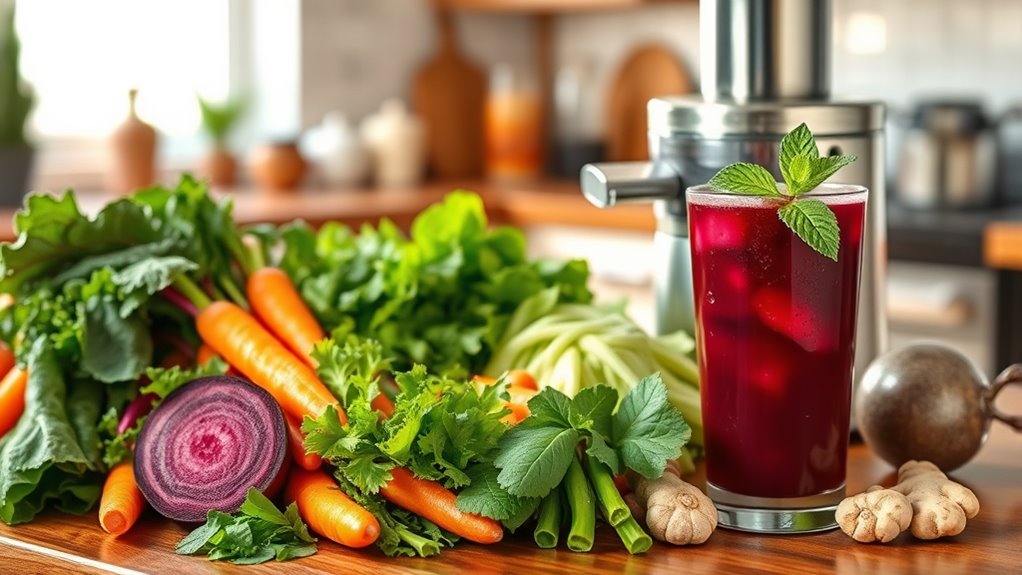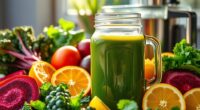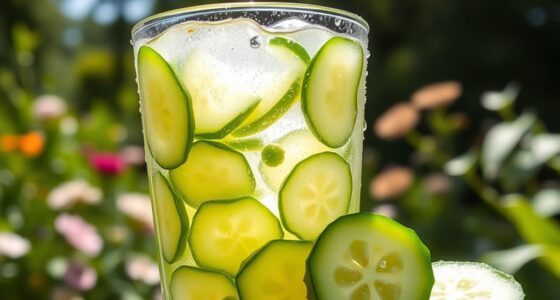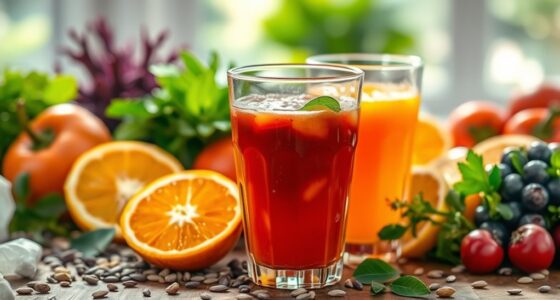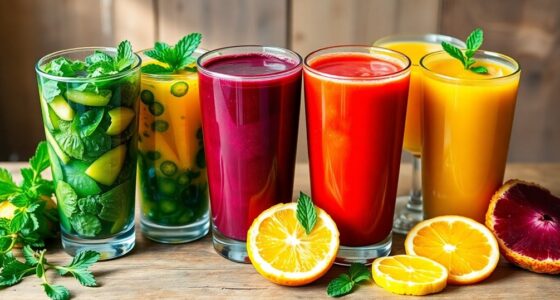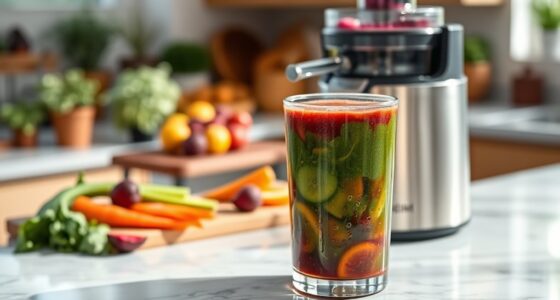Juicing can be your secret weapon against joint pain! By blending anti-inflammatory ingredients like pineapple, ginger, and leafy greens, you’ll support your joints and reduce inflammation. Fresh juices boost hydration and deliver essential nutrients. Aim for a delicious mix, and consume the juice immediately for maximum benefits. The right combinations make all the difference in your health journey. Stick around to discover more tips and recipes that can transform your juicing experience for peak joint relief!
Key Takeaways
- Juicing with ingredients like pineapple and ginger provides potent anti-inflammatory benefits, reducing joint pain effectively.
- Incorporating leafy greens, such as spinach, enhances nutrient intake and supports overall joint health.
- Hydrating ingredients like celery and cucumber help reduce inflammation while promoting hydration.
- Adding turmeric with black pepper boosts curcumin absorption, amplifying its anti-inflammatory effects.
- Freshly juiced blends are most effective when consumed immediately for optimal taste and health benefits.
Key Ingredients for Joint Pain Relief

When you’re looking for relief from joint pain, incorporating certain key ingredients into your juices can make a significant difference.
Pineapple, packed with bromelain, offers powerful anti-inflammatory benefits that help reduce swelling and discomfort.
Adding ginger boosts your juice with antioxidants and further anti-inflammatory properties, aiding muscle recovery.
For an extra punch, green apples are rich in quercetin, a flavonoid known to combat inflammation and support joint health.
Turmeric, especially when paired with black pepper, enhances curcumin’s bioavailability, providing potent anti-inflammatory effects.
Finally, don’t forget hydrating ingredients like celery and cucumbers; they contain compounds that help reduce inflammation.
Additionally, incorporating chia seeds into your juices can provide a plant-based source of omega-3 fatty acids, which are beneficial for overall joint health.
These ingredients work synergistically to create delicious juices that can alleviate joint pain effectively.
Ingredients for the Juice Recipe
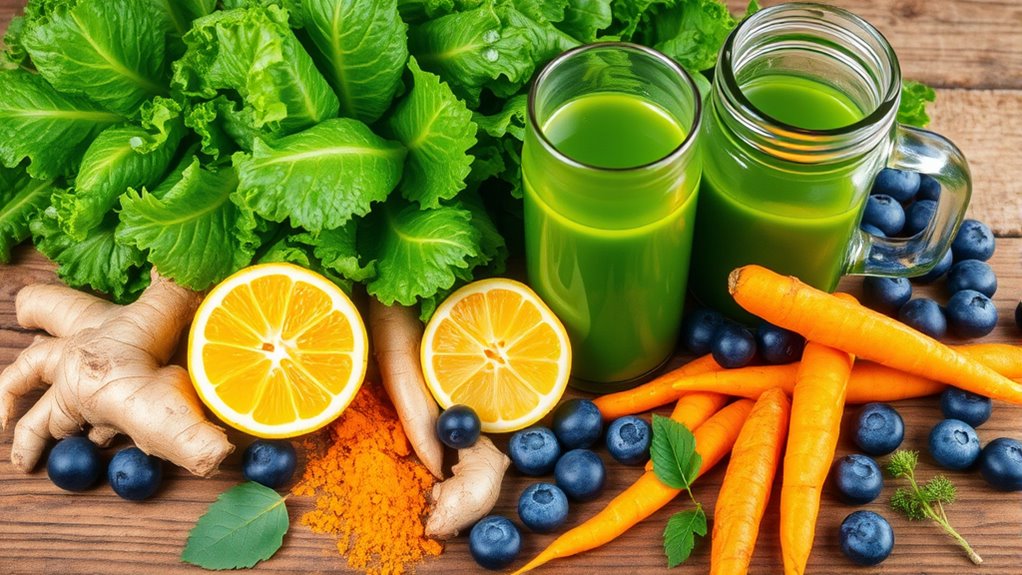
To create an effective juice recipe for joint pain relief, you’ll want to combine a handful of powerful ingredients.
Combine powerful ingredients for an effective juice recipe that helps relieve joint pain and promotes overall health.
These fruits and vegetables not only taste great but also pack a punch against arthritis pain:
- Fresh pineapple – It contains bromelain, known for its anti-inflammatory properties.
- Ginger – This spice adds flavor and offers significant antioxidant and anti-inflammatory benefits.
- Celery and cucumber – Both are hydrating and help alleviate joint discomfort with their anti-inflammatory properties.
- Leafy greens like spinach – Rich in nutrients and antioxidants, they support overall joint health and reduce inflammation.
Don’t forget to add a squeeze of lemon juice for an extra kick and additional health benefits. Additionally, incorporating nutrient-rich ingredients can further enhance the effectiveness of your juice in supporting joint health.
Enjoy your juicing journey!
Step-by-Step Instructions for Preparation
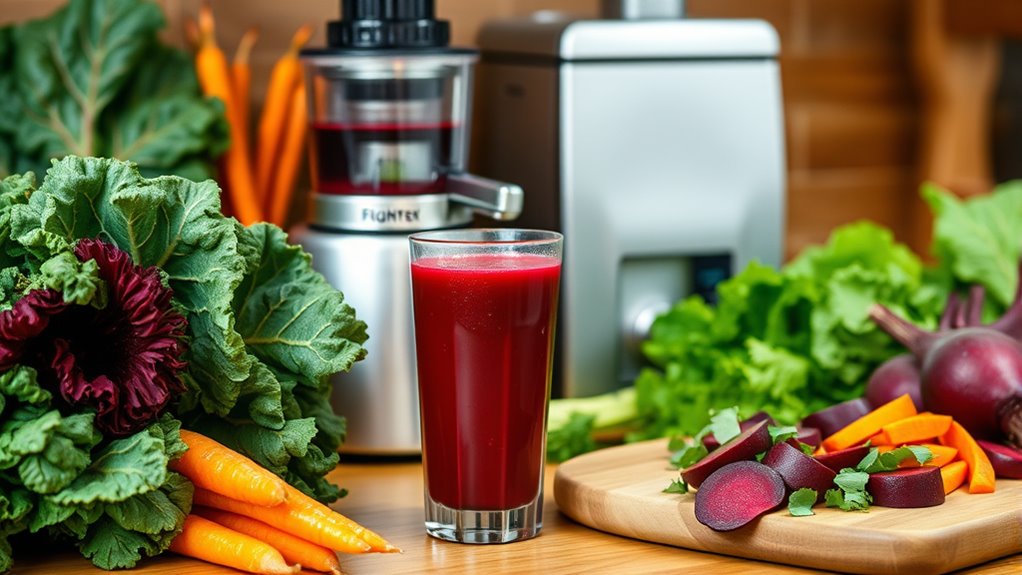
To get started on your juice for joint pain relief, gather your essential ingredients and wash them thoroughly. You’ll want to follow a specific juicing process to maximize the benefits, and I’ll share tips for storing and serving your juice to keep it fresh. Let’s jump into the steps that will help you create a nutritious drink! Additionally, incorporating meal replacement juices can provide essential nutrients while reducing calorie intake, supporting overall health.
Essential Ingredients for Juicing
Creating a revitalizing juice to relieve joint pain starts with selecting the right ingredients. Focus on anti-inflammatory ingredients that can help alleviate discomfort and swelling.
Here’s a list of essential components to include:
- Ginger – Known for its potent anti-inflammatory properties.
- Turmeric – Packed with curcumin, it aids in reducing inflammation.
- Pineapple – Contains bromelain, which may help with swelling and pain.
- Cucumber – Great for hydration and provides essential nutrients.
Combine these with soft fruits and vegetables like celery and spinach for extra hydration and nutrients. Additionally, incorporating vegetable juices like celery and cucumber can further enhance the anti-inflammatory effects of your juice.
Remember to wash everything thoroughly and start juicing with harder veggies for maximum extraction.
Enjoy your delicious blend and feel the benefits!
Juicing Process Explained
Before you plunge into making your juice, make sure to wash all your fruits and vegetables thoroughly. This step’s essential for a clean juice. Start the juicing process by using a high-quality juicer. Begin with fibrous ingredients like ginger and carrots, then follow up with softer items like celery and cucumber. Combine ingredients such as pineapple, green apple, and spinach for a nutritious blend. Remember to check for spoilage signs before using any fruit to ensure the juice’s quality.
Here’s a quick reference for your juicing process:
| Step | Ingredients | Purpose |
|---|---|---|
| 1 | Ginger, Carrots | Maximize juice extraction |
| 2 | Celery, Cucumber | Add hydration and smoothness |
| 3 | Pineapple, Apple | Balance sweetness and flavor |
| 4 | Spinach | Boost anti-inflammatory properties |
| 5 | Optional Strain | Adjust texture to preference |
Drink the juice immediately for the best taste, but you can refrigerate it for up to three days.
Storing and Serving Tips
How can you guarantee your freshly made juice stays flavorful and nutritious? To juice right and get the most health benefits per day, follow these simple storage and serving tips:
- Juice Immediately: Prepare your juices right after extraction to preserve flavor and nutrients.
- Airtight Containers: If you need to store juice, use airtight containers and refrigerate for up to two days.
- Freezing Options: For longer storage, freeze in portions, but remember that thawing may take around two days and can affect quality.
- Strain for Smoothness: Strain your juice for a smoother texture, but keep some pulp for extra fiber and nutrients.
Additionally, incorporating high-fiber content from leafy greens can enhance digestion and improve overall health benefits.
Nutritional Information
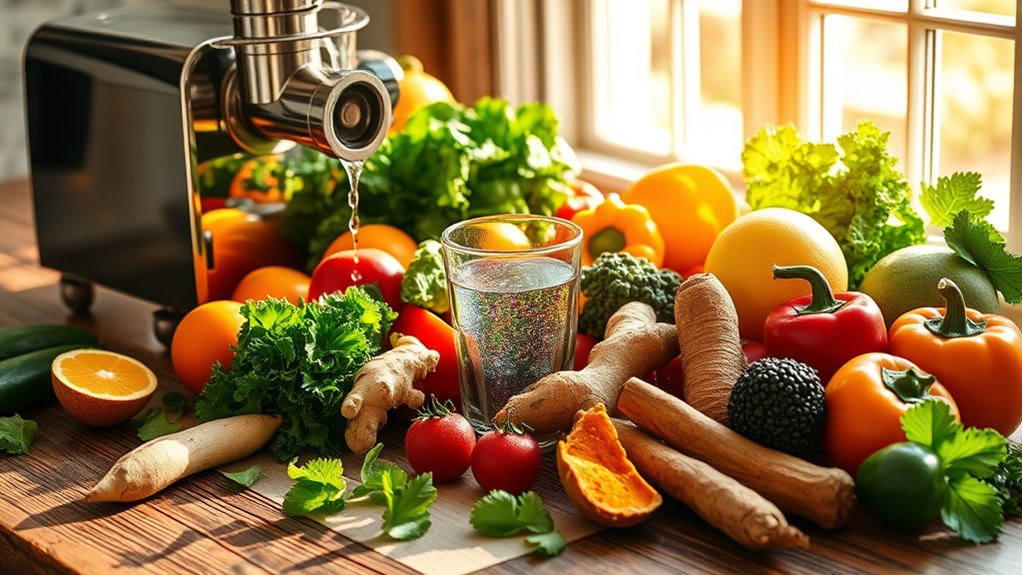
When seeking relief from joint pain, understanding the nutritional information of the juices you consume is essential. Juices made from pineapple and ginger offer a little bit of everything you need, with pineapple providing bromelain to help reduce swelling and ginger delivering powerful antioxidants.
A typical serving contains about 114 calories and 16 grams of sugar, making it a low-calorie option that won’t sabotage your weight management. If you include spinach, cucumber, and celery, you’re adding hydration and nutrients, as celery’s anti-inflammatory properties shine through with just 112 mg of sodium per serving.
Don’t forget carrots and turmeric; they boost your juice with beta-carotene and curcumin, both known for their anti-inflammatory effects. Freshly juiced is best to keep those nutrients intact! Additionally, incorporating natural and organic products can further enhance your overall health benefits.
User Experiences and Feedback
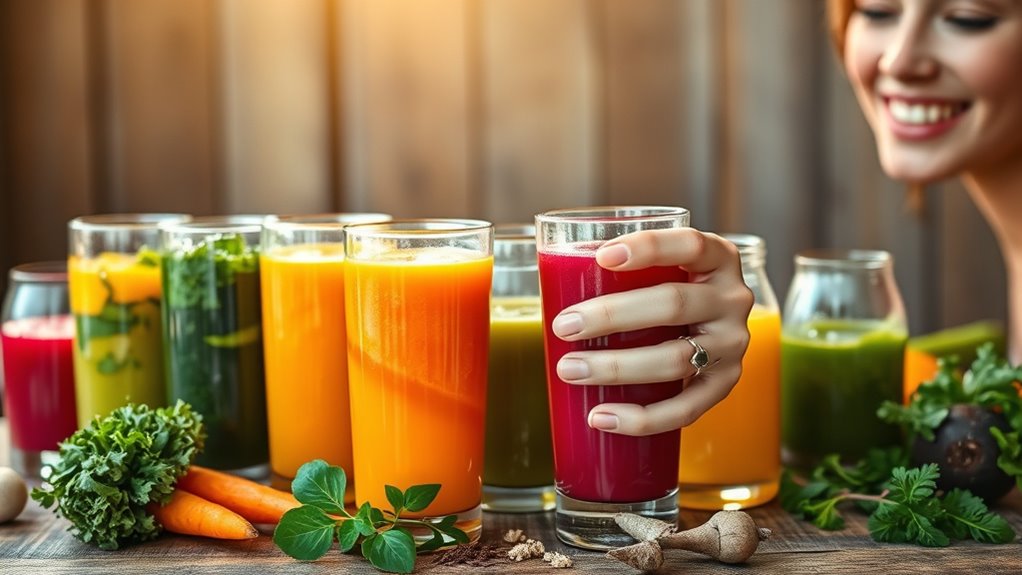
You’ve probably heard about the amazing success stories from others who’ve found relief from joint pain through juicing.
Many users tweak their juice recipes to suit their tastes, which sparks a lively debate on whether a juicer or blender works best.
Let’s explore these experiences and see how they can inspire your own juicing journey.
Personal Success Stories
Many people have discovered the transformative effects of juicing for joint pain relief, sharing inspiring success stories that highlight their journeys.
Here’s what users have experienced:
- Significant Pain Reduction: Many report lower joint pain and inflammation after incorporating juices with ginger and turmeric into their diets.
- Energy Boost: Regular consumption of juice blends, including pineapple and celery, hasn’t only alleviated arthritis symptoms but also improved overall energy levels.
- Fresh Ingredients Matter: Users emphasize the importance of using fresh, organic ingredients to maximize health benefits and enhance pain management outcomes.
- Supportive Community: Individuals often share their experiences, creating a nurturing environment focused on natural approaches to joint pain relief through diet.
These success stories can motivate you to explore juicing as part of your health regimen.
Recipe Adjustments Made
As users experiment with their juice recipes, they’ve discovered that small adjustments can make a big difference in both flavor and nutritional benefits.
For instance, many have opted to reduce or omit ginger to better match their taste buds while still reaping its anti-inflammatory properties. Some have swapped spinach for kale, boosting the nutritional value and aligning with personal dietary choices.
Those with allergies have found success replacing pineapple with papaya, keeping the taste intact without adverse reactions. Additionally, users stress the importance of consuming juice immediately for maximum nutrient retention, often tweaking batch sizes to fit their drinking habits.
Clearer instructions on achieving smoother textures while retaining fiber would also be appreciated in the community.
Juicer vs. Blender Debate
While deciding between a juicer and a blender, you’ll often find that personal preferences play an essential role in the debate. Here’s what you might consider:
- Texture: Juicers create smooth, pulp-free juice, while blenders maintain fiber, aiding digestion.
- Nutrient Density: Juicers deliver concentrated juice with higher nutrients, ideal for anti-inflammatory benefits.
- Convenience: Blenders are quicker for prep and clean-up, handling whole fruits and veggies without straining.
- Versatility: Blenders allow for a wider variety of smoothies, incorporating different ingredients and flavors.
Ultimately, your choice may depend on whether you prioritize taste and texture or nutrient intake and health benefits.
Listen to your body and what works best for you!
Tips for Optimal Juice Preparation
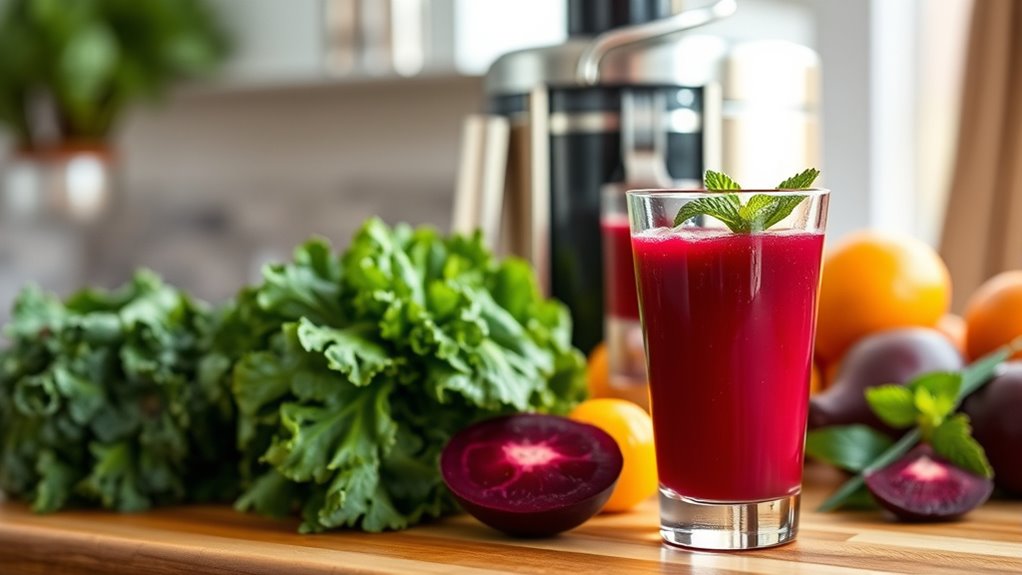
To create the most effective juice for joint pain relief, start by juicing ginger and carrots first, since these ingredients are packed with anti-inflammatory benefits.
Next, incorporate hydrating ingredients like cucumber and celery; they not only boost nutrients but also help reduce inflammation and keep you hydrated.
Consider adding turmeric to your mix, as its anti-inflammatory effects work best with a pinch of black pepper, enhancing its bioavailability.
To achieve a balanced flavor, include a variety of fruits and veggies like pineapple for bromelain and oranges for vitamin C.
Always consume your juice right after preparation for maximum nutrient retention, or store it in an airtight container in the fridge for up to two days if needed.
Additionally, daily consumption of cranberry juice may provide antioxidant benefits, potentially aiding joint health.
Health Benefits of Each Ingredient
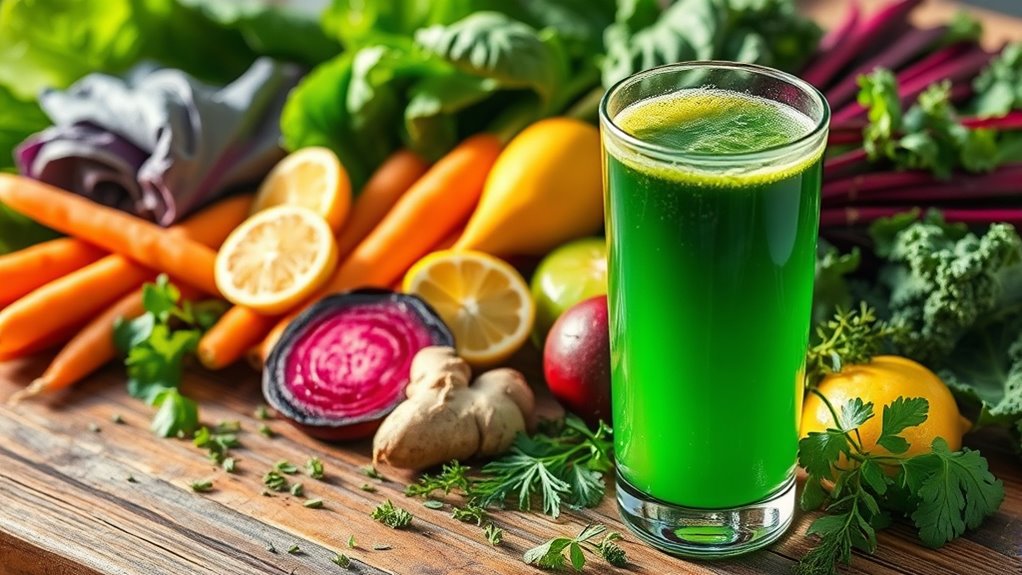
Juicing not only enhances your hydration and nutrient intake but also combines powerful ingredients that specifically target joint pain relief.
Here’s how each ingredient plays an essential role:
- Pineapple: Contains bromelain, an enzyme with anti-inflammatory properties that can help reduce swelling and pain in your joints.
- Ginger: Rich in antioxidants, it effectively alleviates muscle soreness and joint pain with its anti-inflammatory effects.
- Green Apples: Provide quercetin, a flavonoid that may decrease inflammation and support overall joint health.
- Celery: Hydrating and packed with anti-inflammatory compounds, it’s beneficial for those suffering from arthritis.
Incorporating these ingredients into your juice can make a significant difference in managing joint pain. Additionally, understanding filial responsibility laws can help you plan for potential elder care needs and financial implications related to joint health.
Encouragement for a Juicing Routine

Establishing a consistent juicing routine can be a game changer for managing joint pain and enhancing your overall health. By regularly consuming anti-inflammatory juices made with ingredients like pineapple, ginger, and leafy greens, you can markedly reduce inflammation over time.
This routine boosts nutrient absorption, providing essential vitamins and antioxidants that support joint health. Many users notice improvements, with reduced pain levels and increased mobility.
Hydrating juices from cucumber and celery help maintain hydration, which is essential for joint lubrication and comfort. Incorporating juices rich in vitamins A, C, and K, such as parsley juice, can further enhance your joint health. Embracing a juicing habit not only aids in pain management but also encourages a healthier lifestyle.
Frequently Asked Questions
What Is the Best Juice for Joint Pain?
If you’re looking for the best juice for joint pain, try a blend of pineapple, ginger, and turmeric.
Pineapple contains bromelain, while ginger and turmeric are known for their anti-inflammatory benefits.
You might also consider adding celery and cucumber for hydration.
Including green apples and lemons can boost the juice’s anti-inflammatory properties.
Remember to drink your juice right after making it to get the most nutritional benefits and potential pain relief.
What Is the Strongest Natural Anti-Inflammatory for Joints?
Did you know that turmeric’s active compound, curcumin, can reduce inflammation by up to 50% in some studies?
When you’re looking for the strongest natural anti-inflammatory for your joints, turmeric stands out. It’s not just effective; it’s also versatile in cooking and smoothies.
Ginger’s anti-inflammatory properties and omega-3 fatty acids from flaxseeds or walnuts can further support your joint health. Incorporating these into your diet can make a significant difference.
What Is the Most Anti-Inflammatory Juice?
The most anti-inflammatory juice you can make combines ingredients like pineapple, ginger, and turmeric.
Pineapple’s bromelain helps reduce swelling, while ginger adds powerful antioxidants. Don’t forget to include turmeric with a pinch of black pepper to enhance its absorption.
You might also add green apples and lemon for a boost of quercetin and vitamin C.
Vegetables like celery and spinach offer hydration and additional nutrients, making your juice even more beneficial for inflammation.
Which Fruit Is Best for Joint Pain?
Imagine a vibrant garden bursting with colors; that’s what you’ll find in cherries.
If you’re looking for the best fruit for joint pain, tart cherries stand out like a brilliant ruby. They’re packed with anthocyanins, powerful antioxidants that help fight inflammation.
Pineapple is another great option, thanks to its bromelain, which works wonders on swelling.
Incorporating these fruits into your diet can help soothe discomfort and keep your joints feeling spry.
Conclusion
As you commence your juicing journey, think of each ingredient as a dedicated warrior, rallying together to fight the battle against joint pain. With every sip, you’re not just quenching your thirst but fueling your body’s resilience. Picture vibrant greens and bold spices joining forces, forging a shield around your joints. Embrace this daily ritual, and let the power of nature guide you toward relief, transforming your health one delicious glass at a time.
Cindy thoroughly researches juicing trends, techniques, and recipes to provide readers with practical advice and inspiration. Her writing style is accessible, engaging, and designed to make complex concepts easy to understand. Cindy’s dedication to promoting the advantages of juicing shines through her work, empowering readers to make positive changes in their lives through the simple act of juicing.

